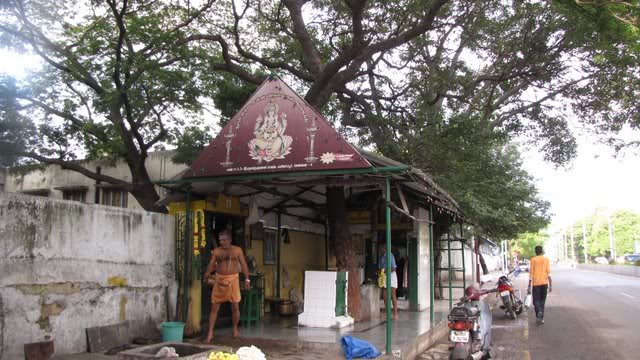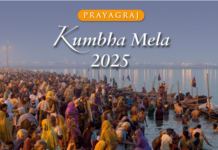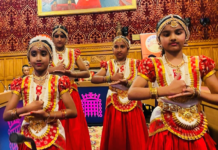THE ROADSIDE SHRINE
By Devdutt Pattanaik
The most powerful pilgrim spot is the roadside shrine. Across India, in villages and towns, in the heart of cities, next to railway stations, in the middle of slums, we find shrines dedicated to various gods and goddesses. It may be a simple vermillion smeared rock, or a photo of Durga riding on a tiger, or an image of Ganesha, or Sai Baba, or the dramatic saffron coloured image of Hanuman with garlands of leaves and flowers. It may be the Christian crucifix with candles before it, or a dargah, replicating the shrine of a Sufi Saint, with a cloth with tassels covering it. In most places, no one really knows who sets up these shrines.
It is all organic. The banyan or pipal trees are favourite spots. Someone places the image, someone prays, eventually some people get together and build a shrine around it, and before you know it, it becomes the local pilgrim spot, giving its name to the neighbourhood. And once it becomes popular, everyone insists the shrine was always there — or at least has been around for five thousand years, that it is self-created, swayambhu, and so cannot be removed for development projects. Many powerful people have figured out that with a temple they can grab public land. Many poor people have figured out that with a temple next to their slum, it becomes difficult for the authorities to kick them out. Religion is a powerful lever in India that informs politics as well as economics.
The best part of the road shrine is to see how it is a multi-functional space. Usually under a tree, it is a lot more crowded with devotees in the morning and in the evening, who stand before it, pray, make offerings, go around it. In the afternoon, it is a place where old people sit and chat, children play, people go about their business ignoring the shrine. At night, dogs enter the shrine, eat some of the leftover offerings, and sleep next to the gods. No one minds.
The shrine, if it becomes slightly popular, becomes a small market, sustaining a small economy, where there are things needed for worship can be bought and sold — flowers, incense, candles, cloth, fruit, sweets, images of deities, threads to tie around the wrist, vermillion powder in small plastic sachets. The shops are mobile, confined to a basket mostly, which appears magically on holy days — like Fridays for Santoshi, Tuesdays for Ganesha, Saturdays for Hanuman. On festival days, the shrine comes alive with lights and music and tents and a whole line of beggars who make the devotees feel guilty for having so much more than them, while asking the deity for more.
Traditionally in India, a holy spot was one associated with a water body (tirtha), usually a pond or a confluence of two rivers, or a bend of a river with a flight of stairs (ghat), or a ford, the shallow part of a river where one can walk across to the other bank. The Puranas are full of lists of such tirthas. And we are told of magical events that happen when one goes to that pilgrim spot: diseases get cured, lost relatives meet, fortune is restored, children are found. Sages travelled from one water body to another water body, carrying with them their ideas and their gods. And so in pilgrim spots around India, we find different religious denominations — there is a shrine of Vishnu and Shiva and the Goddess, even of a tribal god, a local saint, even a mosque and church, built by people whose ancestors may have converted yet value the old pilgrim spots. The idea of India was created not by the British — as Westernised scholars insist — but by the humble pilgrim, who travelled north to south, east to west, meeting his gods.
India is dotted with gods. In every village, there are deities at the entrance, at the border, in the central square, next to farms, some visited only in times of crisis. In cities, we see gods brought in by the migrants — the Khandoba of Marathas, the Momaji and Khatu-shyamji of Rajasthanis, the Shanta Durga of Goans, the Jagannath of Odias, the Durga of Bengalis, and the Vaishno devi of Punjabis. There are gods on the roads interconnecting roads and highways. There is a Hanuman shrine just before you are about to climb a mountain, and a Hanuman shrine at the exit. Drivers throw money at the shrine, and pray for their safety as they make those tough turns and steep climbs. There are gods in every shop, in every tea-stall, in every dhaba. And as if that is not enough, there are gods inside every vehicle, decorated with tassels and flowers.
These are not grand temples built by kings and patronized by Brahmins. These shrines are not regulated by the state. In Europe and America, this will be forbidden. You have to take a license for all religious establishments like you take licenses for shops. But in India, a temple, a mosque, a church can appear just about anywhere, in a small room of the neighbourhood and simply under a tree, to create a sense of community, to give support to the lost and the hopeless and the hopeful, a moment of peace, a moment of connection, with a force that cares more than humanity.
Courtesy: Mumbai Mirror

Readers like you, make ESHADOOT work possible. We need your support to deliver quality and positive news about India and Indian diaspora - and to keep it open for everyone. Your support is essential to continue our efforts. Every contribution, however big or small, is so valuable for our future.












When whole world agrees that God exists everywhere so what is the problem to keep the image of God in which you have faith to keep it with you everywhere. I remember I was attending one of the marriage in London, The father of the girl took me outside the hall and showed me Ganeshji murti ,taking out from his pocket and said Sahdev It is too much tension. I hope Ganesh ji was helping him to remain calm.